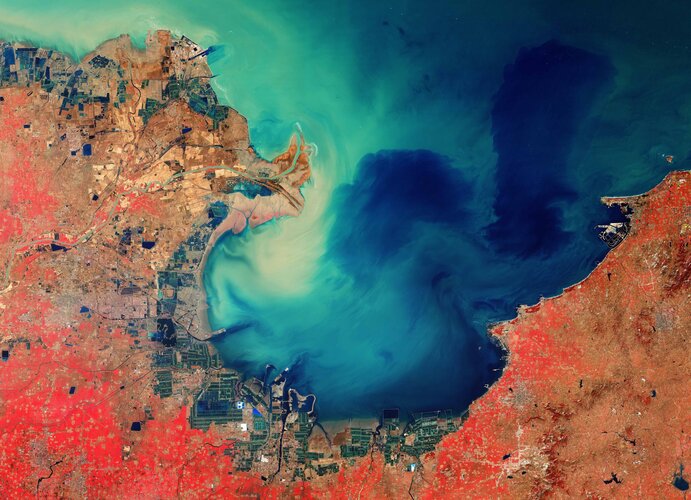
The bay is the smallest of three main bays of the Bohai Sea, and is named after the city of Laizhou, visible to the east. Large quantities of sediment carried by the Yellow River, visible in the left of the image, discolour the waters of the bay and appear turquoise. This sediment can be seen throughout the waters in this image, even far from the coast.
The Yellow River is China’s second longest river, with a length of over 5400 km, and is surpassed only by the Yangtze River. The river rises in the Bayan Har Mountains in Western China and flows through nine provinces before emptying into the Laizhou Bay. Its drainage basin is the third largest in the country, with an area of around 750 000 sq km.
The river is estimated to carry 1.6 billion tonnes of silt annually, carrying the majority to the sea. Owing to this heavy load of silt, the Yellow River deposits soil in stretches, ultimately elevating the river bed. Excessive sediment deposits have raised the river bed several metres above the surrounding ground, sometimes causing damaging floods.
On the southern coast of Laizhou Bay, in the bottom of the image, flooded fields are visible and are most likely artificial fish farms. The city of Dongying, home to the second largest oilfield in China, is visible in the left of the image.
This image was processed in a way that included the near-infrared channel, which makes vegetation appear bright red. The lush vegetation can be distinguished from the brown fields in the image, which are unharvested or not yet fully grown.
Copernicus Sentinel-2 is a two-satellite mission. Each satellite carries a high-resolution camera that images Earth’s surface in 13 spectral bands. The mission is mostly used to track changes in the way land is being used and to monitor the health of vegetation.
This image, acquired on 26 February 2020, is also featured on the Earth from Space video programme.



